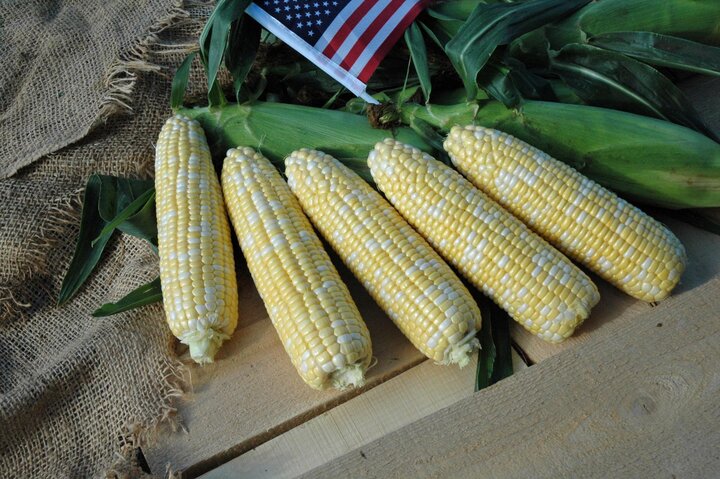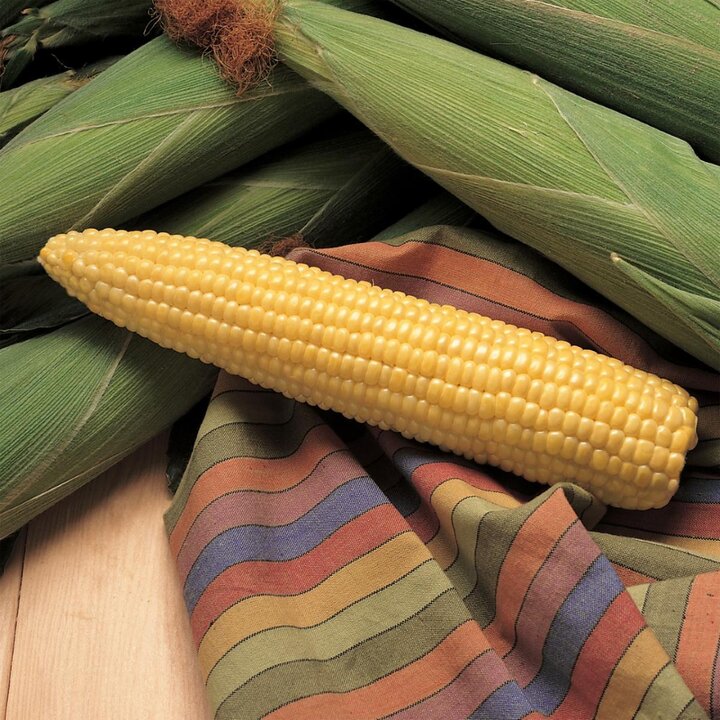Sarah Browning, Nebraska Extension Educator

Obsession, the enjoyment of fresh sweet corn right out of the field. - from the National Garden Bureau.
The final plant of the year, promoted by the National Garden Bureau, is sweet corn. Whether picked fresh from the garden or purchased from the farmers market or local produce aisle, sweet corn continues to be among America’s favorite vegetable.Why is it so Popular?
Versatility! Eaten straight off the cob or included in side dishes, appetizers, entrees, and even desserts; sweet corn can be enjoyed prepared as part of a sweet or savory dish or even popped for a popular snack.
Abundant, adaptable and highly versatile, sweet corn is woven into the fabric of our country’s heritage. First grown by several Native American tribes and given to the Europeans by the Iroquois, the vegetable quickly became a fan favorite.

Types of Sweet Corn"
Sweet corn comes in a variety of colors, most commonly white, yellow, and bicolor (mix of yellow and white kernels). Interesting fact, the pigment color of the kernels is not genetically linked to flavor, so no color kernel sweeter than another.
Sweet Corn is further divided into categories that reflect sweetness, eating quality and shelf life.
- Sugary types (SU) are the original sweet corn types used by your grandparents. They have superior seed quality but the kernels tend to convert sugars to starch quite rapidly, meaning they need to be eaten shortly after harvest.
- Sugary Enhanced types (SE) are much sweeter, have tender creamy kernels and longer shelf life after harvest. You’re most likely to find SE types at local farm stands or farmer’s markets.
- Supersweet or Shrunken (SH2) types have increased sugar levels and maintain their sweetness for a long time for extended shelf life. SH2 types are common in the produce aisles of your local grocery. Some SH2 types require warmer soil to germinate.
- Augmented types have the SH2 genes for super sweet and the kernels are extra juicy and tender like SE types. Augmented varieties need to be isolated from SU types. These seeds need warmer temperatures to germinate.
- Synergistic types produce ears that have 75% SE kernels and 25% SH2 kernels. Synergistic types do not need to be isolated from other types of sweet corn in the field and tolerate cool soil conditions.

Home Growing Recommendations
Unlike many large, tall vegetable plants, sweet corn doesn’t require much hands-on care. Depending on your sweet corn variety, it could take anywhere from 66 to 80 days from the time of planting to harvesting.
- Plant corn seed in the spring once soil temperatures have reached at least 60° F.
- Seeds (kernels) should be planted 1- 1 1/2 inches deep and 9-12 inches apart. Each stalk should produce at least one ear of corn. Plant in a two-week succession for an extended corn season.
- Corn plants have both male (tassel) and female (ear) flowers on the same plant. Every silk in the ear is attached to one kernel allowing it to receive pollen and develop. Without silks on the ear, there will be no kernels. Watch closely for the ear to start showing corn silk – it will be ready to pick about 20 days later.
- Corn is pollinated by the wind so plant in blocks of rows of a single hybrid (as opposed to fewer, longer rows) for good pollination and well-filled ears. Note which type of corn you will be growing because some corn seeds need to be isolated from other types of corn categories for good corn ear development.
- Choose a location that has at least 6 hours of sunlight a day.
- Be sure your corn plants receive about 1″ of water per week. It is important for best ear and kernel development to keep plants watered during the drier times of the season.
- Corn are heavy feeders, especially of nitrogen. Pale green leaves are a sign of nitrogen deficiency. Purple-tinged leaves are a sign of phosphorus deficiency. It is recommended to add fertilizer throughout the growing season if your soil is deficient.
- Corn plants have shallow roots that can be damaged with deep weeding, so lightly hoe or hand weed the area.
- To harvest the corn, grab the ear and twist with a downward motion. Some stalks may grow a second ear of corn and will be ready for picking at a later date.
- Often when an ear of sweet corn is husked, there will be a caterpillar near the tip of the ear and a chewed-up area of kernels. This is a Corn Earworm. If you find this, cut the affected part of the ear off with a knife and cook the rest of the ear.
- Fresh picked sweet corn can be stored for about a week in your refrigerator. If you need to keep it longer, consider freezing for use later in the year.
Popular Sweet Corn Varieties
Ready to grow your own sweet corn? Try these AAS favorites, they’re proven their superior garden performance in trial gardens across North America.
- American Dream F1 – 2018 AAS Winner produces vigorous, healthy plants with cobs that have good tip fill of SH2 bicolored kernels. Matures in 77 days.
- Honey Select F1 – 2001 AAS Winner that gets its name from its sweet, creamy texture and flavor. Harvest golden yellow ears of this Synergistic type in 79 days.
- Honey ‘N Pearl – 1988 AAS Winner well known for its sweet flavor, texture and tenderness. This SH2 type is ready for harvest in 78 days.
- How Sweet It Is F1 – 1986 AAS Winner that’s known for its exceptionally sweet flavor and a tender eating quality. This SH2 type produces pearly white ears in 87 days.
The National Garden Bureau recognizes and thanks Illinois Foundation Seed and Syngenta, NGB members, as authors and contributors to this fact sheet.
Feature Image - Obsession, the enjoyment of fresh sweet corn right out of the field, from the National Garden Bureau.
- American Dream - from the National Garden Bureau
- Honey Select - from the National Garden Bureau
Search Our Archive
Associated Video
Three Sisters Gardening
Kathryn Hain talks about the three sister's gardening concept.